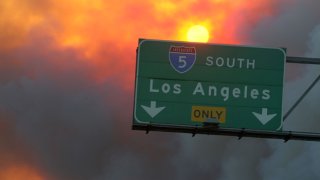
Smoke billows above a highway sign into the sky above where fires are spreading October 22, 2007 in Stevenson Ranch.
Wildfire Preparedness Week started Monday, but this year, getting ready for preparing, training and educating Californians may be a challenge.
The concern is how to safely stage mass evacuations in a time of social distancing. Shelter locations will be limited, so fire departments are asking people to take action now to keep fires from getting out of hand.
Plans are in the works to provide more space at command centers in case of a wildfire to try to limit the number of first responders coming in contact with the virus. But when a wildfire is burning, personnel know they may not be able to follow COVID-19 protocols.
The goal right now though is to focus on prevention. Homeowners need to start preparing now by creating defensible space.
We have seen a spike with 400 fires ahead of our average for this time of year. Five of the deadliest wildfires in California history were in the past three years. Over that time, 145 people lost their lives.
Evacuation Tips
When should I leave?
It is wise to leave the area as soon as an evacuation is recommended. This will help you avoid being caught in a fire, smoke or traffic. This will also help firefighters keep roads clear, which allows them to work without obstacles.
Where should I go?
Call your friends or family who live outside the threatened area and see if they can offer you a place to stay during the evacuation. Your local fire department or city officials will also have designated evacuation shelters.
What should I take with me?
Prepare an emergency kit well before a fire strikes. This kit should include things like a first aid kit, a three-day supply of non-perishable food and three gallons of water per person, spare keys and cash and medication. If time allows, then you should pack easily carried valuables, chargers for your cell phones and laptops, and anything irreplaceable such as family photos.
What about my cat, dog, bird, lizard, etc.?
Ask friends and family if they can shelter your animals during an emergency. Keep a list of 24-hour numbers for pet-friendly places such as animal shelters, pet boarding facilities and veterinarians.
What should I wear?
If you need to go outside while there is an active fire nearby, put on some protective clothing like sturdy shoes, cotton or woolen clothes, long pants, a long-sleeved shirt and gloves.